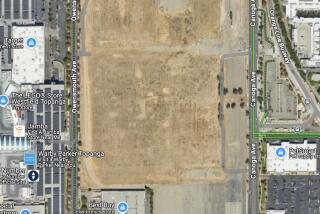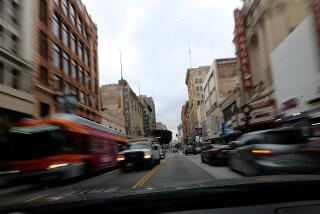Red Line Inspectors Find No Pattern of Poor Work
An independent inspection team detected construction flaws in the Metro Red Line subway--including a 20-foot section of tunnel whose concrete walls are too thin--but said Friday that it found no widespread pattern of shoddy or unsafe work.
The Fluor Daniel Inc. team also said in a separate report that methane gas is not a problem in the subway, despite leaky gas-resistant liners. The highest methane level recorded in the tunnel was 1,600 parts per million, a fraction of the 50,000 p.p.m. considered explosive.
The $100,000 inspections were ordered as a result of allegations by former quality control inspector Mike Quint. Quint, who is suing the Rail Construction Corp. and its contractors for allegedly firing and blackballing him, asserted that blueprints were ignored and substandard components used in parts of the massive construction project.
Most of Quintâs allegations were confirmed in the 35-page report, which said some concrete structures did not conform to plans, some metal parts were smaller than designed and quality control inspectors were untrained, lax or both.
But all except three of these findings were dismissed as âinconsequentialâ by Fluor Daniel and the RCC. Occasionally misplaced reinforcing steel and conduits, improper concrete handling and other deviations from blueprints fall within ânormal construction tolerances,â RCC President Ed McSpedon said.
âWeâre convinced, now more than ever, that we have a sound, safe and secure subway system that will serve the people of Los Angeles for 100 years or more,â McSpedon said.
Quint insisted that the confirmation of many of his allegations--only three of 16 were flatly refuted by inspectors--shows a pattern of nonchalance and shortcuts.
âThis may be a minor item,â he said, referring to the smaller-than-designed size of metal fittings anchoring an escalator to the floor, âbut if they short-cut this, what else did they do?â
Nothing else, said Steve Polechronis, the chief author of Fluor Danielâs reports.
âThere was no evidence of a pattern of slackness,â he said. âWe didnât see a pattern emerge for the intentional disregard for drawings, and we didnât see a pattern emerge for the intentional disregard for inspection.â
The biggest problem confirmed by the report was the thickness of the concrete lining in one of the twin 18-foot-wide tunnels just north of the Civic Center station. The anomaly was found using portable ground-penetrating radar, which measured concrete thickness at dozens of spots randomly selected by the RCC throughout the three-mile length of subway tunnels.
At the problem section, core samples taken from the tunnelâs upper arch indicate that the concrete there is thinner than the 10-inch minimum established by the general engineering contractor.
McSpedon said the tunnel is not unsafe, but will have to be repaired. No one is sure how to fix the problem, he said, but a remedy is being worked out among project engineers, consultants and the contractor, Tutor-Saliba/Groves.
âWeâll find out the cheapest way of doing it,â McSpedon said, âin an effective way with minimum disruptionâ to the subwayâs scheduled March 15 opening date.
The RCC chief blamed the substandard tunnel section on âhuman error.â He said he did not know why it went undiscovered during construction and inspection.
McSpedon and other RCC officials acknowledged that the flawed tunnel segment--which connects Union Station to the Civic Center, and is known by its contract number, A141--has been one of the most troubled in the project.
McSpedon said it was the first major tunnel undertaken by Sylmar-based Tutor-Saliba Corp., the managing partner of the joint venture that is building much of the Red Line. Tutor fell behind schedule in digging the tunnel, then had difficulty pouring concrete for the liner. But after much struggle, it appeared that the job had been done properly.
Since then, Tutor has filed a claim of more than $20 million against the RCC, asserting that the soil conditions along the route were much worse than estimated by RCC when it sought bids on the job. Discovery of this unacceptable tunnel liner--and RCCâs determination to have it fixed at no cost to itself--undoubtedly will complicate settlement of that claim.
The second problem that Fluor Daniel confirmed and recommended be fixed deals with damage caused by a 10-inch hole bored deep into a concrete column in the Civic Center station, where Quint spent most of his time as a quality-control inspector.
Quint alleged that steel reinforcing bars in the column had been severed by the boring, but RCC officials last year denied it. In fact, Fluor Daniel said, five reinforcing bars had been partially or completely severed and should be replaced.
The consultant said that although there was no apparent attempt to physically cover up the error, it could not find a required nonconformance report in project files. Such paperwork is needed to inform engineers and inspectors of potentially significant deviations from plans.
Missing paperwork also was noted in the third problem Fluor Daniel found, which involved the gas-resistant plastic liners in one section of the subway.
Quint alleged that workers hired to install the thick black polyethylene sheets showed up on several occasions without the equipment needed to make sure that the seams did not leak, telling him that the equipment was broken. His memo on the problem was ignored by the contractor, Quint said.
Inspectors said they could not find the memo in the project files, nor any quality control records relating to the tunnel liners for five months in 1989. But they did find a nonconformance report confirming Quintâs charges, and recommended that methane gas levels be watched closely in that tunnel section.
Methane appears to be much less of a problem than initially suspected, inspectors said. Gas levels were found to be far below those that would set off the super-sensitive gas detectors installed throughout the system, Fluor Daniel said.
For most of the projectâs life, the inspectors said, methane levels have remained below 0.1% of the concentration considered explosive. Even if they were to inexplicably rise, the report said, the subwayâs detectors and ventilation fans can easily manage the situation.
The inspectors did not confirm Quintâs most alarming allegation--that some structures lack adequate steel reinforcing bars and might not withstand a powerful earthquake, or even years of normal wear and tear.
Magnetic testing indicated that there was âerratic spacingâ between the bars, but all of the required steel was there, Fluor Daniel said.
âThere were no recorded indications of the alleged missing (reinforcing bars),â the report said.
On other allegations, Fluor Daniel was less definitive.
Quint said several colleagues told him they were ordered not to inspect certain procedures because their inspections cost the contractor time or money. The Fluor Daniel team dismissed the allegations by saying it had not been able to find the other inspectors, most of whom have either been fired or moved on to other jobs.
Quint also alleged that inspection reports had been falsified by unqualified inspectors, but the review team said it could not find the reports.
More to Read
Sign up for Essential California
The most important California stories and recommendations in your inbox every morning.
You may occasionally receive promotional content from the Los Angeles Times.










